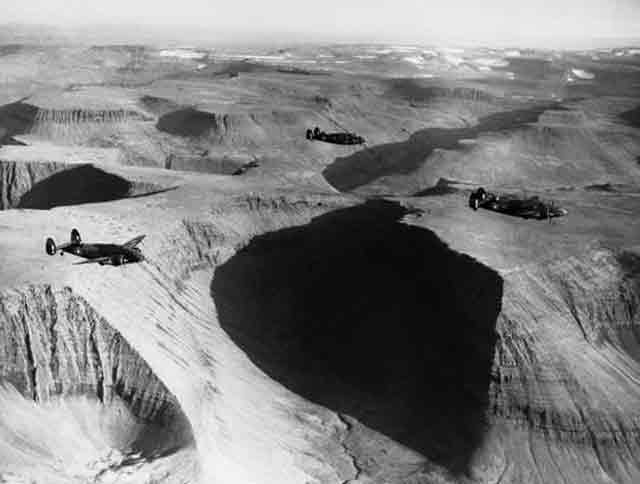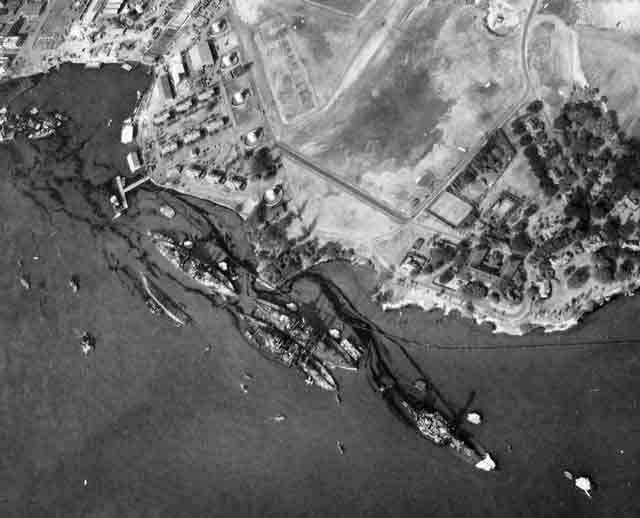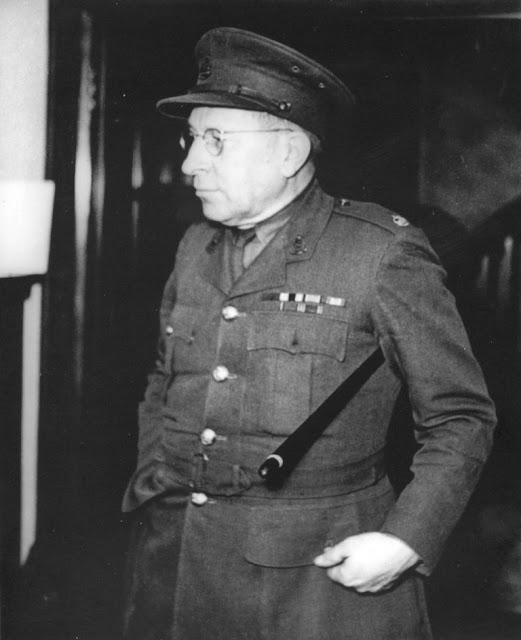Friday 30 May 1941
 |
| On or about 30 May 1941, a Fordson Armoured Car of No. 2 Armoured Car Company RAF, operating with 'Habforce', waits outside Baghdad, Iraq, while negotiations for an armistice take place between British officials and the rebel government (Imperial War Museum Collections Collection No.: 4700-20; Reference Number: CM 923). |
Anglo/Iraq War: The British 4th Cavalry Brigade of 1st British Cavalry Division, an advance party of Habforce troops, arrives at Baghdad on
30 May 1941 and opens talks for surrender. The entire Habforce only numbers 1200 men, with eight guns and a few armored cars, but the numerically superior Iraqi troops refuse to fight them. The British occupy the nearby airfield.
Iraqi leader Rashid Ali has left for Persia, taking his soldiers' monthly payroll of 17,000 dinars. Accompanying him are the Grand Mufti and the rest of the Iraqi government. They head for Germany.
The British are expanding their cushion around their main base at Habbaniya airfield. They attack Ramadi, about a dozen miles northwest of Habbaniya. Another large British force from Basra advances past Ur. The Indian 25th Infantry Brigade arrives aboard ship at Basra.
Dr. Fritz Grobba, the head of the German diplomatic mission to Baghdad, leaves the capital today. There now is no longer any German presence in Iraq, as the small Luftwaffe contingent is in disarray with all of its planes out of operation. There is a force of about ten Italian Fiat Cr 42 biplane fighters, but they also prepare to flee from their base at Kirkuk.
British Middle East Commander General Archibald Wavell's Air Force releases a statement:
In Iraq our fighter squadrons flew patrols throughout the day in support of our advancing troops while Italian aircraft tried to prevent them. One of these aircraft was shot down ar Khanugh (Iraq). A number of British reconnaissance planes and bombers operated in cooperation with motorised units. We have destroyed the hangars on the airfield at Deir ez Zor in Syria. In Abyssinia, South African aircraft attacked Italian troops still fighting near Gimma. Direct hits were observed on buildings, as were a number of fires. Several Italian motor trucks went up in flames north of Alegh. Forts Azozo and Digya were bombed at Gondar (Ethiopia). In Libya, an enemy bomber wing yesterday undertook an assault on Tobruk; anti-aircraft succeeded in shooting down four of them and several others were damaged. Five of our own aircraft failed to return from these operations.
British Prime Minister Winston Churchill is still concerned about the Iraqi oil fields - he sends a memo to General Ismay warning of a "fierce and justifiable outcry if we fail to destroy these oil fields before they fall into enemy hands."
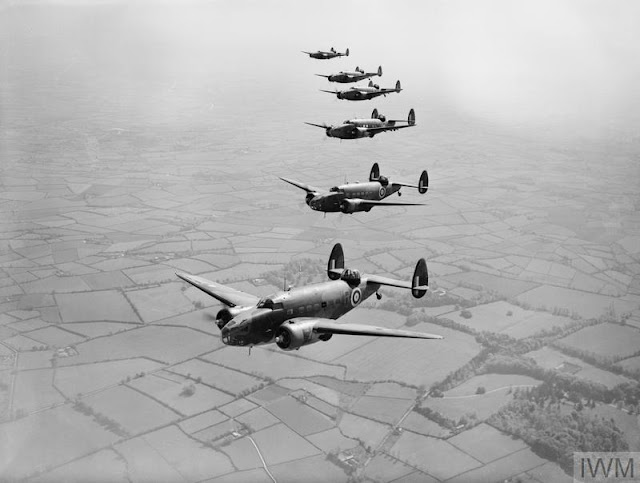 |
| "Lockheed Hudson Mark IIs and IIIs of No. 233 Squadron RAF based at Aldergrove, County Antrim, flying in starboard echelon formation over Northern Ireland." 30 May 1941 © IWM (Daventry B J (Mr), CH 2841). |
European Air Operations: After dark, Luftwaffe bombers attack the Bristol area and the Mersey industrial area.
About 30 German planes cross England and bombs Dublin just after midnight on 31 May. The local inhabitants send up a flare to denote their status as neutrals, which the Germans disregard. Areas hit include Phoenix Park (home of the Dublin Zoo) and the North Strand area. Overall, 34 people perish, 90 are wounded, twenty homes are destroyed, 55 greatly damaged and 400 people left homeless. The Irish lodge a diplomatic protest in Berlin, to which the Germans reply that "there can be no question of any intentional attack on Éire territory." The Reich blames "high winds" on the "error."
RAF Bomber Command sends a dozen aircraft on a coastal sweep.
Churchill tells Sir Archibald Sinclair, Secretary of State for Air (and also the leader of the Liberal Party) that the RAF should supply the Army with "the modest force they require" for Army co-operation squadrons. This means transferring 30 Blenheim bombers now and 30 more (for an army reserve) at a later date.
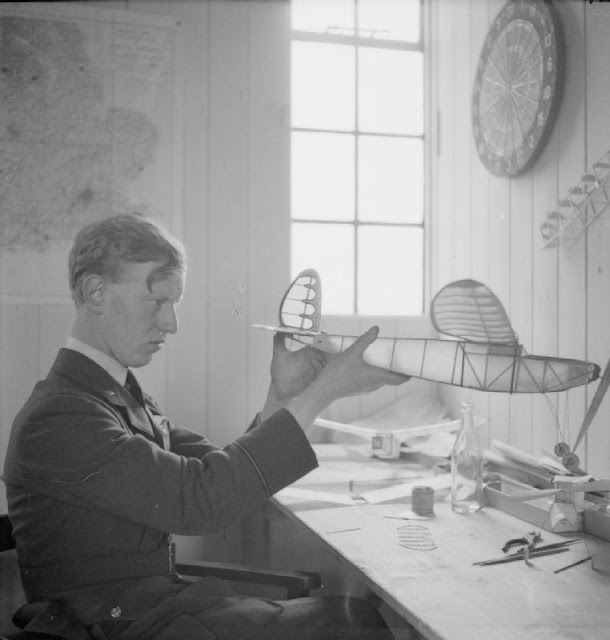 |
| "Pilot Officer James 'Ginger' Lacey DFM and Bar, hard at work on a model airplane in No 501 Squadron's dispersal hut at Colerne, 30 May 1941." © IWM (CH 2814). |
East African Campaign: Churchill sends Middle East Commander Wavell a cable about "Jibuti," meaning French Somaliland:
It will be convenient to have this place in the near future, and I shall be glad if you will consider what forces would be necessary to break the French resistance.... The time to strike depends, of course, upon events in Syria which ma lead to a breach with Vichy.
In the meantime, he urges a continuation of the blockade "with the utmost strictness."
The East African 22nd Infantry Brigade, advancing west from Soddu, reaches Sciola in Galla-Sidamo. The Italian defenders withdraw from Sciola after dark.
 |
| Empire Protector, sunk 30 May 1941 by U-38 off Freetown, Sierra Leone. |
Battle of the Atlantic: U-106 (Kptlt. Jürgen Oesten), on its second patrol out of Lorient and operating west of the Cape Verde Islands, torpedoes 6373-ton British freighter Silveryew at 00:36. There is one death. The 53 survivors take to the boats and land at San Antonio, Cape Verde Islands.
U-38 (Kptlt. Heinrich Liebe), on its 9th patrol out of Lorient and operating off Freetown, Sierra Leone, torpedoes and sinks 6181-ton British freighter Empire Protector. There are five deaths, including the Master, John Cringle. The 33 survivors are taken aboard Dutch freighter Arundo.
Italian submarine Marconi, operating on its third patrol out of Bordeaux as part of BETASOM, torpedoes and sinks 8129-ton British naval tanker Cairndale southwest of Trafalgar. There are 4-5 killed. A large group of Royal Navy escorts attack the Marconi, but it gets away.
An unidentified submarine torpedoes 6990-ton British tanker British Yeoman in the same general vicinity where the Marconi is operating. However, apparently, the torpedo is defective, because minimal damage is caused. The British Yeoman makes it to Gibraltar for inspection.
British 2842-ton freighter Westavon hits a mine and sinks south of Clacton-on-Sea in the Thames Estuary. Everyone survives.
The Luftwaffe bombs and damages 700-ton British freighter Kyleclare off Limerick.
HMCS Ottawa and Restigouche arrive in St. John's, Newfoundland to join the new Newfoundland Escort Force (NES).
Convoy SL 76 departs from Freetown bound for Liverpool.
Royal Navy corvette HMS Myosotis (Lt. Gerald P. S. Lowe), sloop Gorleston (Commander Ronald W. Keymer) and submarine P-33 (Lt. Reginald D. Whiteway-Wilkinson) are commissioned.
 |
| New York Times, 30 May 1941. |
Battle of the Mediterranean: Evacuations continue of British soldiers on Crete. At Sfakia, destroyers HMS Napier and Nizam take off 1510 men. The Luftwaffe catches them as they sail for Alexandria and damage both with near misses. Overall, 6029 Commonwealth troops are taken off on 30 May before dawn and again before midnight, but there are many more waiting for evacuation.
German motorcycle troops moving east from Suda and Canea (Chandia) link up with Italian troops and armor heading west from their landing ground at Sitia. They can now head south toward Sfakia, where the British are busy evacuating their troops. Troops of the 1st Fallschirmjäger Regiment reach Heraklion (Candia), linking up with the German garrison there. While in doubt only days earlier, Operation Mercury is turning into a roaring success.
The Luftwaffe attacks the Royal Navy ships evacuating the Commonwealth troops from Crete. These include Australian cruiser HMAS Perth, damaged in its engine room with 13 dead, destroyer HMS Kelvin, also damaged, and cruiser Calcutta sunk northwest of Alextrania.
 |
| A map on page 2 of the 30 May 1941 New York Times showing the situation on Crete. |
Brigadier Vasey's Australian 19th Infantry Brigade serves as the rearguard for the evacuation, but British, Greek and New Zealand troops also fight hard. New Zealand soldier Charles Hazlitt Upham receives the Victoria Cross for his services on Crete through 30 May. Today, his platoon disperses an advance party of German soldiers coming down a ravine near Force Headquarters at Sfakia.
There are British troops left behind all across Crete. Remnants of Australian 2/1 and 2/11 battalions, which have been cut off, surrender near Retimo (Rethymno).
Partisan activities continue on Crete. At this stage, they mainly involve helping Commonwealth troops defend specific locations, but there are instances of sniping and full-scale armed defense of villages. The Germans are quite upset that non-soldiers are fighting them and vow revenge.
The Luftwaffe bombs and sinks 105 ton Greek freighter Aghios Pantlemon off Tobruk.
There is a major incident when 3821-ton Bulgarian freighter Knyaguinya Maria Luisa (Fürstin Maria Luisa) explodes at Piraeus, Greece. As it blows up, it also destroys 2140 ton German freighter Alicante and 3127-ton Romanian freighter Jiul (Ziul). There are multiple casualties on all three ships, a tug, and also Italian freighter Adis Abeba. Damage to the city of Piraeus is minimized only because the ship does not explode at once, but only while being towed to a shipyard by tugs. There is a dispute as to the cause of this explosion: Greek partisans claim that their sabotage sinks the Maria Luisa, while RAF Wellington bombers also may be the cause.
Royal Navy submarine HMS Triumph torpedoes and damages 3667-ton Italian armed merchant cruiser (AMC) Ramb III. The Ramb II is sailing from Tripoli to Benghazi and makes it to port.
Royal Navy submarine HMS Utmost attacks an Italian convoy off Sirte but causes no damage.
Royal Navy submarine HMS Torbay claims to sink two caiques in the Aegean using its deck gun.
At Malta, the Cheshire Regiment lands on Gozo, which the British fear may be used for an invasion of Malta.
Spy Stuff: In Tokyo, Richard Sorge sends another message to Moscow. It begins:
Berlin informed [German Ambassador to Japan] Ott that German attack will commence in the latter part of June. Ott 95 percent certain war will commence.
As he has with numerous other warnings about Operation Barbarossa, Soviet Premier Joseph Stalin disregards this warning. In fact, he has had his staff work up plans for an invasion of Germany (see the Zhukov Plan of 15 May 1941).
 |
| Actress Hansi Knoteck on the cover of Filmwelt, 30 May 1941. |
Anglo/US Relations: The US Coast Guard transfers the tenth Lake-class cutter, USCGC Itasca, to the Royal Navy as HMS Gorleston. The Itasca is famous for being the ship anchored at Howland Island in the Pacific which received the final transmissions from aviators Amelia Earhart and Fred Noonan.
Anglo/Arab Relations: Prime Minister Winston Churchill sends a memo to Foreign Secretary Anthony Eden telling him that "No encouragement should be given to those suggestions of treachery and bad faith on our part towards the Zionists." The Revisionist Zionist Movement has alleged that the British are moving toward a more conciliatory policy toward Arab interests due to the war in Iraq. He notes that "I am quite certain that we should lose in America far more than we should gain in the East."
German Military: Admiral Raeder meets with Hitler to argue for his "peripheral strategy" against Great Britain. He proposes that the Wehrmacht launch a "decisive Egypt-Suez offensive for the autumn of 1941 which would be more deadly to the British Empire than the capture of London." Hitler decides to wait until after he defeats the Soviet Union in Operation Barbarossa. There remains a large body of opinion among members of the German government and Wehrmacht that is opposed to Operation Barbarossa, and this is one of their final attempts to dissuade Hitler from invading the Soviet Union.
Ireland: The Fianna Fáil government of Éamon de Valera signs into law the Second Amendment of the Constitution of Ireland. Among other things, it includes restrictions on the right to habeas corpus, an extension of the right of the government to declare a state of emergency, changes to provisions dealing with the reference of bills to the Supreme Court by the president and various changes needed to bring the official Irish text of the constitution into line with the English text.
Siam: King Rama VII Prajadhipok, former King of Siam from 1925 to 1935, passes away.
Holocaust: The German occupation authorities introduce repressive measures against the Jewish population of Yugoslavia. Among other things, all persons now identified as Jews (the definition has just been decided) are forced to wear the yellow Star of David.
 |
| Manolis Glezos and Apostolos Santas, who tear down the Reich swastika flag on the Acropolis on 30 May 1941. |
Greek Homefront: Two university students named Manolis Glezos and Apostolos Santas climb on the Acropolis and tear down the swastika flag. This is considered a seminal point in the Greek resistance of World War II.
American Homefront: Drivers Floyd Davis and Mauri Rose win the Indianapolis 500. This is the last race involving a winning car carrying two drivers. After this, the race is suspended until 1946.
Abbott and Costello comedy "In the Navy" is released. The Andrews Sisters, Dick Powell, and Shemp Howard also appear. This is the comedy duo's follow-up to smash hit "Buck Privates" and is another big hit, becoming the sixth most popular film of 1941.
Future History: Marisa Solinas is born in Genoa, Italy. She goes on to become a popular singer and actress in Italy. She appears in Bernardo Bertolucci's film debut, "
La commare secca" (The Thin Gossip) (1962).
Roberto Calasso is born in Florence. He becomes a top Italian intellectual and writer.
 |
| USS North Carolina. "View looking aft from the battleship's bow, showing her forward superstructure and 16"/45 guns. Photographed during her maiden voyage, circa May 1941. Note Measure 1 camouflage paint, CXAM-1 radar antenna, anchor chains, and deck planking." (US Navy). |
May 1941 May 1, 1941: British Hold TobrukMay 2, 1941: Anglo-Iraq WarMay 3, 1941: Liverpool HammeredMay 4, 1941: Hitler Victory SpeechMay 5, 1941: Patriots DayMay 6, 1941: Stalin In CommandMay 7, 1941: May BlitzMay 8, 1941: Pinguin SunkMay 9, 1941: U-110 CapturedMay 10, 1941: Hess Flies Into HistoryMay 11, 1941: The Hess Peace PlanMay 12, 1941: Tiger Arrives SafelyMay 13, 1941: Keitel's Illegal OrderMay 14, 1941: Holocaust in ParisMay 15, 1941: Operation BrevityMay 16, 1941: Blitz EndsMay 17, 1941: Habbaniya RelievedMay 18, 1941: Croatia PartitionedMay 19, 1941: Bismarck at SeaMay 20, 1941: Invasion of CreteMay 21, 1941: Robin Moore SinkingMay 22, 1941: Royal Navy Destruction Off CreteMay 23, 1941: Crete Must Be WonMay 24, 1941: Bismarck Sinks HoodMay 25, 1941: Lütjens' Brilliant ManeuverMay 26, 1941: Bismarck StoppedMay 27, 1941: Bismarck SunkMay 28, 1941: Crete LostMay 29, 1941: Royal Navy Mauled Off CreteMay 30, 1941: Sorge Warns, Stalin IgnoresMay 31, 1941: British Take Baghdad2020




